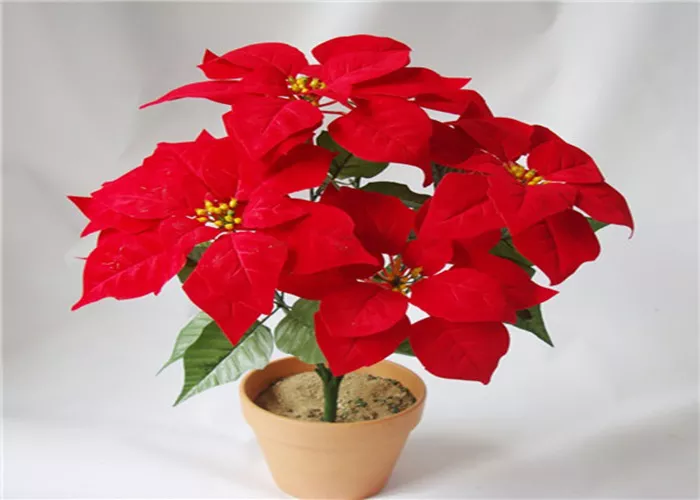Christmas, celebrated annually on December 25th, is a festive season filled with joy, love, and giving. It marks the birth of Jesus Christ, bringing hope and redemption to the world. This holiday is celebrated with various traditions and symbols, one of which is the use of flowers to decorate homes, churches, and public spaces. Among the myriad of flowers associated with Christmas, one stands out as the most popular: the Poinsettia.
Origins and Symbolism of the Poinsettia
The Poinsettia, scientifically known as Euphorbia pulcherrima, is a native plant of Mexico. Its popularity during Christmas stems from its vibrant red bracts, which are often mistaken for petals. These bracts, along with the green leaves and yellow flowers, create a striking and festive appearance. The Poinsettia’s association with Christmas began in the early 19th century, thanks to Joel Roberts Poinsett, the first United States Ambassador to Mexico.
Poinsett, during his tenure in Mexico, was fascinated by this beautiful plant and brought it back to the United States. He cultivated it in his greenhouse and shared it with friends and botanical gardens. Soon, the plant’s vibrant colors and festive aura made it a perfect addition to Christmas decorations. Over time, it became synonymous with the holiday season, symbolizing joy, love, and the spirit of giving.
Cultural Significance
The Poinsettia holds cultural significance beyond its aesthetic appeal. In Mexico, where it originates, the plant is known as the “Flores de Nochebuena” or “Flowers of the Holy Night.” It is deeply intertwined with the country’s Christmas traditions. According to folklore, the Poinsettia’s red bracts represent the stars that guided the shepherds to find Jesus in the fields. The green leaves symbolize eternal life, while the yellow flowers represent the gold given to Jesus by the shepherds.
In the United States, the Poinsettia has become a staple of Christmas decorations. It is often placed in prominent locations such as near the fireplace, on dining tables, or as centerpieces on holiday buffets. Its bright red color adds a warm and festive touch to any home, making it a perfect choice for the winter holiday season.
Why the Poinsettia Is the Most Popular Christmas Flower
Several factors contribute to the Poinsettia’s popularity as the most beloved Christmas flower.
1. Vibrant Color and Appearance
The Poinsettia’s striking red bracts, green leaves, and yellow flowers create a visually appealing display. Its vibrant color stands out during the winter months, bringing a sense of warmth and joy to any space.
2. Longevity
Unlike other holiday flowers that may wither and fade quickly, the Poinsettia has a relatively long lifespan. With proper care, it can last for weeks, providing a lasting touch of Christmas cheer.
3. Versatility in Decorating
The Poinsettia’s versatility makes it a perfect choice for various decorating styles. It can be used in wreaths, garlands, centerpieces, or simply placed in a vase. Its compact size and lush foliage also make it easy to incorporate into any holiday decor.
4. Symbolism
Beyond its aesthetic appeal, the Poinsettia carries deep symbolic meaning. It represents joy, hope, and the spirit of giving, making it a perfect symbol for the Christmas season.
5. Availability and Affordability
The Poinsettia is widely available during the holiday season. Many nurseries, garden centers, and grocery stores stock this plant, making it easily accessible to consumers. Additionally, its price is relatively affordable, allowing many people to enjoy its beauty without breaking the bank.
Care and Maintenance of Poinsettias
To ensure your Poinsettia lasts throughout the holiday season, proper care and maintenance are essential. Here are some tips to keep your Poinsettia healthy and vibrant:
1. Light
Poinsettias thrive in bright, indirect sunlight. Avoid placing them in direct sunlight, which can scorch the leaves. If natural light is limited, supplement with artificial light to ensure the plant receives enough light to stay healthy.
2. Temperature
Poinsettias prefer warm temperatures. Keep them away from cold windows or doors and avoid exposing them to drafts. A temperature range of 65-75°F (18-24°C) is ideal.
3. Watering
Water your Poinsettia when the soil feels dry to the touch. Avoid overwatering, which can lead to root rot. Allow the top inch of soil to dry out before watering again. Use a well-draining pot to prevent water from pooling at the bottom.
4. Fertilization
During the growing season (spring and summer), feed your Poinsettia with a balanced, water-soluble fertilizer every two weeks. Reduce feeding during the fall and winter when the plant is not actively growing.
5. Pruning
In the spring, prune your Poinsettia to encourage bushy growth. Remove any leggy or dead branches, and pinch back new growth to promote a fuller plant.
Conclusion
The Poinsettia stands as the most popular Christmas flower, embodying the joy, love, and giving spirit of the holiday season. Its vibrant color, longevity, versatility in decorating, deep symbolism, and availability make it a perfect choice for any home. With proper care and maintenance, your Poinsettia can bring a lasting touch of Christmas cheer to your home throughout the holiday season.
As we gather with family and friends to celebrate the birth of Jesus Christ, let us remember the true meaning of Christmas: love, hope, and redemption. The Poinsettia, with its beautiful red bracts and festive aura, serves as a perfect reminder of these cherished values. So, this holiday season, bring a Poinsettia into your home and let its beauty and symbolism fill your heart with joy and gratitude.


